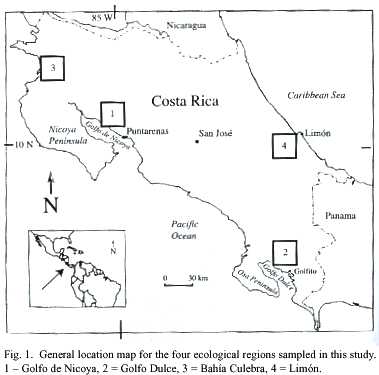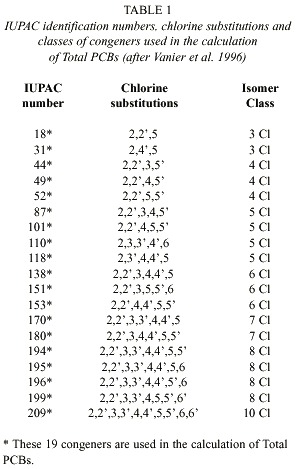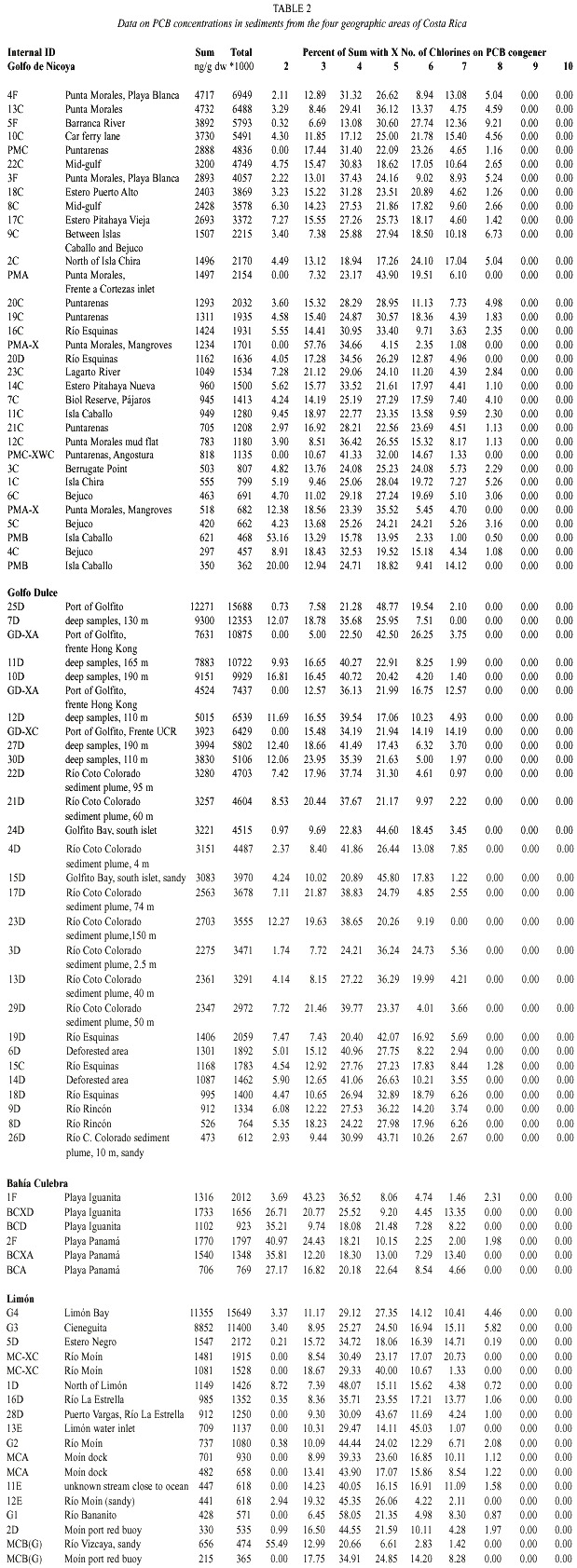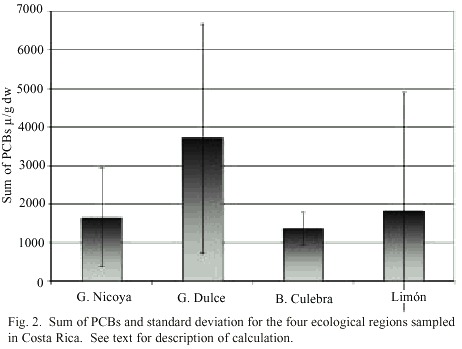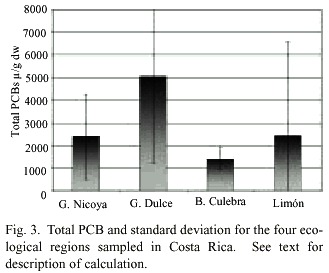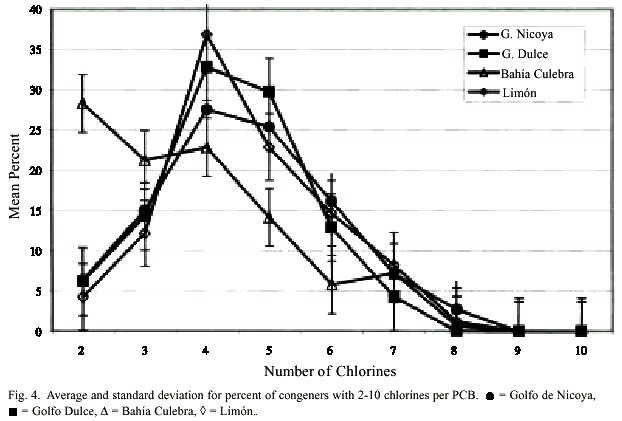Services on Demand
Journal
Article
Indicators
-
 Cited by SciELO
Cited by SciELO -
 Access statistics
Access statistics
Related links
-
 Similars in
SciELO
Similars in
SciELO  uBio
uBio
Share
Revista de Biología Tropical
On-line version ISSN 0034-7744Print version ISSN 0034-7744
Rev. biol. trop vol.52 suppl.2 San José Dec. 2004
in the coastal waters of Costa Rica
Alison L. Spongberg
Department of Earth, Ecological and Environmental Sciences, Mail Stop 604, University of Toledo, Toledo, Ohio 43606-3390; aspongb@utnet.utoledo.edu
Phone: (419)530-4091. Fax: (419)530-4421.
Received 22-IV-2003. Corrected 02-III-2004. Accepted 07-IV-2004.
Abstract
This paper describes the initial investigation of PCB concentrations in four geographical regions (three on the Pacific and one in the Caribbean) of coastal Costa Rica: Bahia Culebra, Golfo Dulce, Golfo de Nicoya, and Limón. Overall total concentrations of PCB were low in all areas except around the port of Golfito (Golfo Dulce). Overall average concentration is 2.80 ng/g dw, with a standard deviation of 2.75. The low concentration could be due to lack of contamination or the subsequent degradation in the warm climate, or the low sorptive capacity of the sediment. Further investigation is ongoing.
Key words: Polychlorinated biphenyls (PCB), coastal pollution, organic contamination, Costa Rica.
The production of polychlorinated biphenyl compounds, (PCBs), was banned in the United States in 1976 under the Toxic Substance Control Act and water column concentrations have begun to diminish in the U.S. However, the use of PCBs in other countries has not been as well regulated. Releases into the environment include improper disposal, leakage, incineration and volatilization (Rappe 1993).
Polychlorinated biphenyl compounds are thermally stable, resistant to both biotic and abiotic degradation, and ubiquitous in the environment. These compounds are detected in virtually all environmental samples, having been released during industrial and combustion processes (Rappe 1993). Their contamination is widespread, occurring globally at locations distant from sources and detected at some level in virtually all living organisms. The geochemical properties of the group of PCB compounds include high K ow and low water solubilities; therefore, these pollutants readily adsorb onto organic matter in marine sediments and suspended in the water column. Other transport pathways include atmospheric dry and wet deposition into the marine environment (Broman et al. 1992). The presence of even low concentrations of PCB pollutants can be a continued and future source of in place contamination of the water column. PCBs are hydrophobic and can accumulate within living organisms and may be mutagenic, carcinogenic, endocrine disrupting, neurotoxic and/or teratogenic. Thus, they may continue to be an ecological and human threat.
The objective of the current investigation was to determine the extent of PCB contamination in the coastal sediments of four different ecological regions in Costa Rica. These areas have been targeted for intensive ecological and environmental study. No previous PCB work has been conducted in this country and no baseline work has been done in any tropical areas for comparison. Therefore, this study may provide a baseline evaluation from which to assess future studies, as well as a guideline for selection of sites in which to conduct more detailed studies.
Previous studies have been undertaken to assess the levels of PCB contamination in marine sediments in areas thought to have a significant contamination problem. Levels as high as 16 267 pg g-1 dw (picograms per gram dry weight of sediment, sum of 23 congeners) were found in the Arkona Basin of the Western Baltic Sea and Oder River estuary (Dannenberger et al 1997). The drainage basin is highly agricultural and pesticide contamination is high. Concentration distribution was attributed to sediment dynamics and resuspension and transport processes. Lee et al (2001) similarly investigated the PCB contamination in estuarine sediments on the west coast of Korea. Concentrations ranged from near the detection limits to greater than 580 ng/g-OC (normalized to organic content). The source area is contaminated by shipping activities, several factories and large amounts of sewage input. As the sample locations distance from the proposed contaminant source increased, the total PCB concentrations decreased and the relative proportion of lower chlorinated biphenyls increased.
A more recent fresh water investigation found total PCB concentrations in soils and sediments from two high altitude European mountain lakes of 0.41–15 ng g-1 dw, with the authors concluding the absence of major pollution sources in these high mountain regions (Grimalt et al. 2003). In contrast, a study by Loganathan et al (1997) on the PCB contamination in a polluted sewershed on the Buffalo River in New York is typical of results elsewhere in the United States influenced by intense human activities. The majority of total PCB concentrations ranged from 100-270 ng g-1 dw in particulate phases in the river water, with the dissolved phase and atmospheric deposition being significantly less. Correlation was found between the PCB congeners in street dust and the congeners found in the river sediments.
Materials and methods
Study area: Sediment samples were obtained from the coastal areas of Costa Rica in four diverse ecological regions (Figure 1). Bahia Culebra, Gulf of Papagayo is a region of tropical upwelling on the northwestern Pacific coast and is composed of highly productive waters and biologically rich reefs. The continental platform is relatively narrow, favoring the influence of oceanic waters on the coastal waters with periods when unusually colder waters may be present (Jiménez 2001). Golfo Dulce is a deep (up to 200 m) fault-bounded fjord-like gulf located on the southwestern Pacific coast. The western side of the gulf is the Osa Penninsula which has experienced little human influence. The port city of Golfito is on the eastern side of the gulf and was found in a previous study to have considerable metal and organic pollutant contamination (Spongberg and Davis 1999). Golfo de Nicoya is a tropical estuary on the central Pacific coast. Its length is about 90 km and the width is about 50 km (Vargas 1995). The quality of sediments in Golfo de Nicoya is influenced by the thriving cities of Punto Morales and Puntarenas and the water shed for the capital city of San Jose. The area of Limon was the only sampling location of the Caribbean side of the country. Limon is surrounded by shallow warm waters with numerous coral reefs. The sediment quality in the nearshore environment is dominated by human activities of the city and port and the abundant fruit plantations the dominate the landscape. Samples for analyses were obtained during five separate sampling trips as follows: January, 1996 (Golfo de Nicoya and Golfo Dulce), September, 1997 (Golfo Dulce), June, 1999 (Golfo de Nicoya, Golfo Dulce and Limon), 2001 (Bahia Culebra) and August, 2002 (Golfo de Nicoya, Bahia Culebra). Data on pesticide content for many of the Golfo Dulce samples were presented in Spongberg and Davis (1999).
Analytical procedures: Samples were prepared as follows. Estuary and shallow samples were collected by hand with a clean core barrel and immediately placed in either prewashed glass jars or plastic bags, depending on the subsequent analyses. Samples were sealed and frozen immediately after collection and transferred to the University of Toledo, Toledo, Ohio still frozen. Samples were dried and re-frozen until analysis. All samples were analyzed for grain size distribution using the standard hydrometer technique. Organic matter content was analyzed by thoroughly ashing the oven-dried samples in a muffle furnace at 500ºC, rehydration and drying at 100ºC and comparing pre-and post-ashing weights.
The analysis of PCBs followed a modified versions of the EPA Methods 8080 and 3620 (Foreman et al. 1995). Approximately 10 to 20 g of dried sediment were extracted using a Soxtec Organic Extraction Unit for one hour, using methylene chloride or acetone:methylene chloride (1:1) as the solvents. Samples were immersed in the boiling solvent for fifteen minutes, followed by their suspension over the refluxing solvent for an additional 45 minutes. Sulfur was removed from the extracts by reaction with approximately 1 gram of freshly activated copper overnight. Separation and clean up were achieved by passing the extract through a glass column containing approximately 12 g of florisil (60/100 mesh) topped with sodium sulfate, with diethylether in hexane (3:1) as the eluant. Isooctane was added as a stabilizer. The eluate was evaporated to 2 ml or less using a rotary evaporator. One m l was used for the gas chromatographic analysis. All solvents were pesticide grade.
Analyses were performed on a Hewlett Packard 6890 gas chromatograph equipped with a SPB-5 fused silica capillary column (30 m length, 0.25 mm ID, 0.25 m m film thickness, Supelco, Inc.) attached to either a 63Ni electron capture detector (HP 5890 Series II) or a mass selective detector (HP 5972). The carrier and make up gas (for ECD) gases were ultra-high purity helium and nitrogen. Oven temperature was held at 80°C for 2 minutes and programmed to increase at 3°C/min to 280°C and held for 5 minutes. The injection and ECD detector temperatures were 275°C and 320°C, respectively. The mass selective detector was run in selective ion monitoring mode for help in identifying congeners and detecting lower concentrations.
Quality control included reagent blank determination, matrix spike (0.2 and 1.0 μg/g) recovery, and precision analysis. 2,3,5- trichlorobenzene was used as an internal standard. Calibration was checked routinely. Quantification of individual PCB congeners in samples was made by comparison to standard mixtures and confirmed using the extensive library of mass selective detector signatures of individual congeners. Recovery efficiencies varied between 65 and 95%. Detection limits were calculated using the area of the baseline noise over the elution time of each congener using low concentration standards. Limits of detection were three times the standard deviation of the baseline noise, and averaged 0.2 ng/g. Relative standard deviation of data from five consecutive duplicate runs was 3-5%. Data reported are not corrected for blank concentrations or recovery efficiencies.
Results
The data on these congeners is expressed in two ways. The sum of the congeners identified in this study is presented as ΣPCBs. However, because different studies usually identify different congeners and different numbers of congeners, these studies can be difficult to compare. Therefore, the data are also presented as Total PCBs. As stated in Vanier et.al (1996), 19 congeners make up about 50% by weight of all congeners in Arochlor 1242, 1253, 1262, 1254, and 1260 (Table 1). Therefore, the concentrations of these 19 congeners are summed and multiplied by 2 and reported as Total PCBs in this study. This value can, hopefully, be more useful for comparisons in future studies. Details on individual basins and individual congeners are given in a subsequent paper.
Table 2 lists the PCB data for the Costa Rican sediments. Data are divided by geographic location and include the ΣPCBs and Total PCB concentrations, as well as the percentage of total concentration by number of chlorine atoms on the congener.
Discussion
Note that all samples except those from the Golfito area in Golfo Dulce have very low total PCB concentrations. The average sum of congeners analyzed in this study was 2.80 ng/g dw, with a standard deviation of 2.75. The average of the Total PCBs was slightly higher at 3.83, with a standard deviation of 3.66. These numbers are much lower than most values found in the United States and other contaminated areas in temperate climates. For example, sediments along the Hudson River have been analyzed with total PCB concentrations as high as 50 ng/g dry sediment weight. However, the soils found in many areas of Costa Rica are dominated by hydrous oxide clays which do not have an affinity for sorption of these compounds. Most sediments analyzed from temperate climates are dominated by young 2:1 silicate clay minerals that readily sorb many contaminants. The organic fraction in the Costa Rican sediments ranges from low values of 0.26% to great than 3%. Organic contaminants, such as PCBs, have a greater affinity to sorb to the organic fraction than to the clays.
Another reason why the values of Total and Sum PCBs are low might be the warm temperatures in this tropical area. Degradation reactions tend to increase as temperature increases. Therefore, if PCBs were present they may be degrading in this favorably warm climate. Although the possibility that these areas just do not have much PCB contamination should also be considered a reasonable explanation. Many of the sampling locations are remote and would not be expected to have high contamination.
Previous work on these same sediments from Golfo de Nicoya and Golfo Dulce has shown that they also contain comparatively low concentrations of pesticide contaminants (Spongberg and Davis 1999). Conclusions from that work point to either the absence of contamination in many areas, conpounded with the lack of sorptive capacity within the sediments.
The average and standard error of the Sum and Total PCB concentrations for the individual areas are shown in Figures 2 and 3. The average values for Golfo de Nicoya, Papagayo and the Caribbean sediments are similar at 1.66, 1.36, and 1.80 ng/g dw for the Sum PCBs, respectively, and 2.42, 1.41, and 2.42 ng/g dw for Total PCBs, respectively. However, the average Sum and Total values for Golfo Dulce are 3.61 and 4.93, respectively, which is statistically significantly higher than the other three areas. Interestingly, Golfo Dulce is surrounded on the west and north by largely pristine, undeveloped lands, with development only in the Golfito Bay area and agriculture in the Coto Colorado watershed. The water depth in Golfo Dulce, however, is much deeper than in any of the other sampled areas, with many samples taken in waters greater than 100 meters. In general, the samples with the highest concentrations of PCBs were taken from either the deep samples in Golfo Dulce and in the heavily used port of Golfito. But, overall, all samples analyzed from Costa Rica show relatively low concentrations of PCBs and are indicative of a lower than average risk associated with the sediments.
Figure 4 is a plot of the average and standard errors for the percent of congeners with varying numbers of chlorines (from 2-10). No congeners with 10 chlorines were identified in these samples, however, these compounds could be identified in the standard solutions. Whether this is due to analytical error, chemical change during sampling and transport, or whether this is indicative of the samples is not known. Whereas the concentration data mentioned previously separates the sediments from Golfo Dulce apart from the other areas, the distribution of chlorines on the Golfo Dulce PCBs is relatively similar to those from the Caribbean and Golfo Nicoya. Statistically, however, the PCBs from the Bahia Culebra area are distinct. A high percentage of these samples were dominated by congeners with fewer chlorine atoms. In fact, more than 50% of all congeners from that area contained 4 or fewer chlorines. Although it is relatively common to lose the lower chlorinated PCBs during analysis, no reason exists why this phenomenon would be biased towards samples from a particular geographic area. Therefore, this trend must be real and not an analytical artifact. The Papagayos (Bahia Culebra) samples appear to be atmospherically deposited compounds, since the lower chlorinated compounds have higher vapor pressures and thus are more likely to be carried further from their source. Alternatively, the Bahia Culebra samples may indicate rapid degradation within the sediments, since the typical pattern for PCB degradation is loss of chlorines from the biphenyl structure. Since there is no known reason why this geographic region, dominated by upwelling Pacific currents, ought to promote accelerated dechlorination, it is likely that these low concentration contaminants do not have a local or currently active source. This questions the validity of the calculation of Total PCBs for the Papagayos samples. The calculation is based on the percentage of congeners found is relatively unaltered Alochlor products and does not consider their redistribution upon degradation or biased partitioning during atmospheric transport.
A little less apparent in Figure 4 and Table 2, but nevertheless significant is the greater percentage of higher chlorinated PCBs in the samples from the Golfito area of Golfo Dulce, and many of the samples from Golfo de Nicoya and Limon. If PCBs are degrading within the environment the compounds tend to become slowly dechlorinated. These samples that still contain high chlorinated congeners are an indication of either lack of degradation or the presence of nearby or recent releases into the environment. Golfo de Nicoya actually contains samples displaying both the same trend found in Papagayos and in the Limon samples. It appears that within this gulf, some recent releases may be occurring. This variability within Golfo de Nicoya and Golfo Dulce is expounded upon in greater detail in the subsequent article.
In conclusion, it is important to note that the overall concentrations of PCB contaminants in all sediments sampled from the four geographic regions in coastal Costa Rica are low. Current research is investigating whether these low values are due to a lack of contamination source in the local areas, or the low affinity of these sediments to adsorb the compounds and therefore a lack of retention of the contaminants within the sediments, or the rapid degradation of the compounds either prior to or following deposition.
Acknowledgements
For this and all work I have done in Costa Rica I sincerely thank the tremendous efforts and kindness of José Vargas, former Director of the Centro de Investigación en Ciencias del Mar y Limnología (CIMAR), and Jenaro Acuña, both at the University of Costa Rica, San Pedro. Eleazar, Davis, Ruth, and many others at CIMAR went out of their way to help make this research a success. Last, but certainly not least, I wish to thank the Costa Rica-United States of America Foundation for Cooperation (CR-USA) for partially funding this project.
Resumen
Este articulo describe una investigación sobre las concentraciones de bifenilos policlorados (PCB) en cuatro regiones geográficas (tres en el Pacífico y una en el Caribe) costeras de Costa Rica.: Bahía Culebra, Golfo Dulce, Golfo de Nicoya, y Limón. Las concentraciones totales de PCB fueron bajas en todas las regiones excepto en el puerto de Golfito (Golfo Dulce). Las concentraciones promedio fueron de 2.80 ng /g dw, con una desviación estándar de 2.75. Las bajas concentraciones pueden estar asociadas a: la ausencia de contaminación por PCB, la degradación posterior en éste clima cálido, o la poca capacidad de absorción de los sedimentos.
References
Broman, D., C. Naf & Y. Zebühr. 1992. Occurrence and dynamics of polychlorinated dibenzo-p-dioxins and dibenzofurans and other combustion related organic pollutants in the aquatic environment of the Baltic. Chemosphere 25: 125-128. [ Links ]
Dannenberger, D., R. Andersson & C. Rappe. 1997. Levels and patterns of polchlorinated dibenzo-p-dioxins, dibenzofurans and biphenyls in surface sediments from the Western Baltic Sea (Arkona Basin) and the Oder River estuarine system. Mar. Poll. Bull. 38: 1016-1024. [ Links ]
Foreman, W.T., B.F. Connor, E.T. Furlong, D.G. Vaught & L.M. Merten. 1995. Methods of analysis by the U.S. Geological Survey National Water Quality Laboratory – determination of organochlorine pesticides and polychlorinated biphenyls in bottom sediment by dual capillary-column gas chromatography with electron-dapture detection. USGS Open-File Report 95-140. 78p. [ Links ]
Grimalt, J. O.; B. L. van Drooge, A. Ribes, R. Vilanova, P. Fernandez & P. Appleby. 2004. Persistent organochlorine compounds in soils and sediments of European high altitude mountain lakes. Chemosphere 54. 1549-1561. [ Links ]
Jiménez, C. 2001. Seawater temperature measured at the surface and at two depths (7 and 12 m) in one coral reef at Culebra Bay, Gulf of Papagayo, Costa Rica. Rev. Biol. Trop. 49: 153-161. [ Links ]
Lee, K.T., S. Tanage & C. Koh. 2001: Contamination of polyshlorinated biphenyls (PCBs) in sediments from Kyeonggi Bay and nearby areas, Korea. Mar. Poll. Bull. 42: 273-279. [ Links ]
Loganathan, B.G., K.N. Irvine, K. Kannan, V. Pragatheeswaran & K.S. Sajwan. 1997. Distribution of selected PCB congeners in the Babcock Street Sewer District: a multimedia approach to identify PCB sources in combined sewer overflows (CSOs) discharging to the Buffalo River, New York. Arch. Environ. Contam. Toxicol. 33: 130-40. [ Links ]
Rappe, C. 1993. Environmental concentrations and eco-toxicological effects of PCDDs, PCDFs, and related compounds. DIOXIN 93, Organohalogen Compounds 12: 163-170. [ Links ]
Spongberg, A.L. & P. Davis. 1999. Preliminary investigation of pesticide contamination in Golfo Dulce, Costa Rica. Rev. Biol. Trop. 46 (Suppl.5): 111-124. [ Links ]
Vanier, C., M. Sylvestre & D. Planas. 1996. Persistence and fate of PCBs in sediments of the Saint Lawrence River. The Science of the Total Environment 192: 229-244. [ Links ]
Vargas, J.A. 1995: The Gulf of Nicoya estuary, Costa Rica: past, present, and future cooperative research. Helgoländer Meeresunters 49: 821-828. [ Links ]
Wang, H., J.A. Kostel, A.L. St. Amand & K.A. Gray. 1999. 2: The response of a laboratory stream system to PCB exposure: study of periphytic and sediment accumulation patterns. Water Res. 33: 3749-3761. [ Links ]













